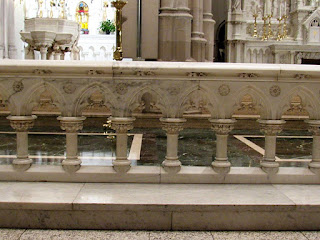 |
| (Image Source: Wikimedia Commons) |
As we face the tragic reality that so few Catholics believe our Lord is really and substantially present in the Holy Eucharist, we must be honest in assessing the reasons why this has occurred. While there are many possible explanations, there is one common denominator: we abandoned sacred rituals and conduct for the banal - discarding that which elevated our minds and hearts to the heavenly King, for practices that center on ourselves and the mundane.
So many Catholics today either do not remember or never experienced the sacred practices of days gone by. It is important then that those practices and the reasons for them be shared anew if we are ever to re-establish belief in, awe and amazement for our Eucharistic Lord.
Actions do indeed speak louder than words:
Toward that end, let me share again the observations of columnist, James Monti:
“Across the centuries, it has been the tradition in Catholic
architecture to set a boundary between the nave and the sanctuary, setting
apart the altar and its immediate surroundings from the rest of the church. In
the early Christian basilicas this took the form of a chancel wall, sometimes called
the templon. Over the centuries that followed, there came the altar rail and
the rood screen. In the Eastern liturgies, it has taken the form of the
iconostasis.
Far from being an impediment to our communion with God, this
cloistering of the altar, this physical barrier, teaches the soul the
incomparable beauty of what is transpiring beyond it, and the infinite goodness
and majesty of Him who dwells beyond it. The Church architect, Dennis McNamara,
has described the altar rail as the symbolic boundary 'where heaven and earth
meet, where the priest, acting in persona Christi, reaches across
from heaven to earth to give the Eucharist as the gift of divine life' (Joseph
Pronechen, 'Altar Railing Returning to Use,' National Catholic Register, posted online
July 2, 2011)
This reservation of the sanctuary heightens our love and
longing for the sacred and bestows a sublime character on those special
privileged moments when one is permitted to enter its holy precincts. For the
priest, this is a daily privilege, but by no means one that he should take for
granted. The altar rail reminds us all that on such holy ground we are only the
invited guests, the privileged visitors."
(From The Journey Deep Into The Sacred published in the September 5, 2019 issue of The Wanderer)
What harm, this writer asks, could possibly befall our parishes if we return to those practices (restoration of sacred silence within our Churches, altar rails, reception of Holy Communion on the tongue and while kneeling, and celebrating Mass ad orientem where we all face the Lord we have come to adore and worship) - all of which have proven through the centuries to foster an authentic belief in our Lord's Presence in the Eucharist and to instill and sustain a sense of the sacred in our Churches and among our people?
None.
More importantly, our Lord deserves nothing less!
More importantly, our Lord deserves nothing less!


.jpg)




